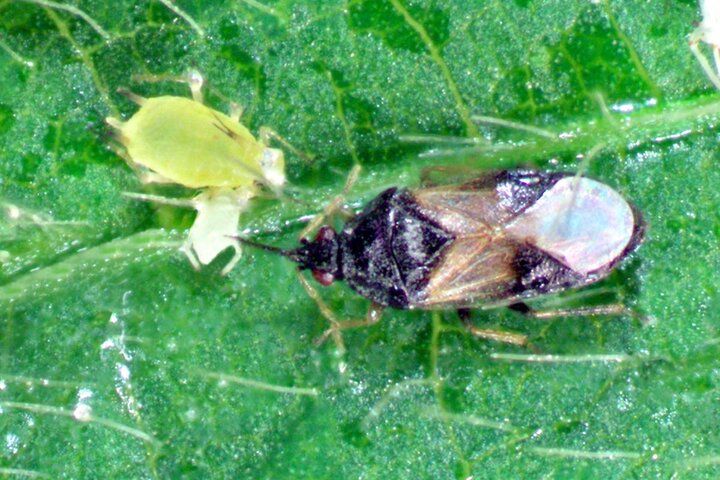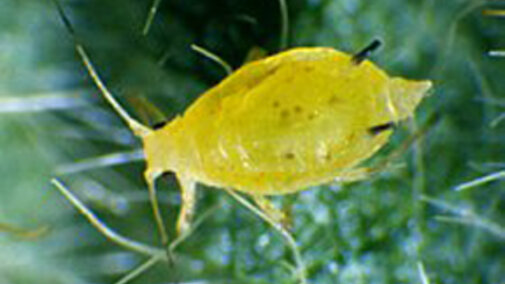Also see the companion article, Scouting and Managing Soybean Aphid, in this week's CropWatch.
Although soybean aphids have been hard to find in Nebraska soybean this year, now is the time to be vigilant. Spraying for soybean aphid is underway in central Minnesota and populations are building in southwest Minnesota, reported Bruce Potter, integrated pest management specialist at the University of Minnesota Southwest Research and Outreach Center near Lamberton, Minn. We expect the summer migrants to arrive in Nebraska soon. We have monitored soybean fields in past years that were almost devoid of aphids in mid-July, but by mid-August were well over 2000 aphids per plant. If you have not yet begun to scout for aphids, start now.
Soybean Aphid Description
The soybean aphid is soft-bodied, light green to pale yellow, less than 1/16 inch long, and has two black-tipped cornicles (cornicles look like tailpipes) on the rear of the abdomen. It has piercing-sucking mouthparts and typically feeds on new tissue on the undersides of leaves near the top of recently colonized soybean plants. Later in the season the aphids can be found on all parts of the plant, feeding primarily on the undersides of leaves, but also on the stems and pods.
Soybean Aphid Life Cycle
The seasonal life cycle of the soybean aphid is complex with up to 18 generations a year. It requires two species of host plant to complete its life cycle: common buckthorn and soybean. Common buckthorn is a woody shrub or small tree and is the overwintering host plant of the aphid. Soybean aphids lay eggs on buckthorn in the fall. These eggs overwinter and hatch in the spring, giving rise to wingless females. These females reproduce without mating, producing more females.
Soybean aphids have been reported in most soybean-producing regions of Nebraska, although the highest and most economically damaging populations typically occur in northeast Nebraska.

Also see:
After two or three generations on buckthorn, winged females are produced that migrate to soybean. Multiple generations of wingless female aphids are produced on soybeans until late summer and early fall, when winged females and males are produced that migrate back to buckthorn, where they mate. The females then lay eggs on buckthorn, which overwinter, thus completing the seasonal cycle. Nebraska lacks significant and widespread buckthorn populations, and so early season soybean colonization by aphids migrating from buckthorn appears to be limited.
Soybean aphid populations can grow to extremely high levels under favorable environmental conditions. Reproduction and development is fastest when temperatures are 70°-85°F. Aphid numbers can change rapidly. Populations can double in two to three days under optimal conditions. The aphids do not do well when temperatures are in the 90s, and are reported to begin to die when temperatures reach 95°F. When temperatures drop below 48°F, development stops.
When populations reach high levels during the summer, winged females are produced that migrate to other soybean fields. Like a number of other insect species (e.g., potato leafhoppers), these migrants can be caught up in weather patterns, moved great distances, and end up infesting fields far from their origin. These summer migrants are likely the major source of initial infestations in Nebraska.
Soybean Aphid Natural Enemies
There are many insect predators of soybean aphid. The most visible soybean aphid predator is the multicolored Asian lady beetle; however, the tiny (1/10-inch long) insidious flower bug (or Orius; Figure 2) is the most common and important predator. It feeds on a variety of small insects and spider mites. Naturally occurring predators, primarily the insidious flower bug, can significantly slow soybean aphid population growth, particularly during our hot July weather. Resident populations of predators also help reduce the rate of successful colonization of soybeans by the soybean aphid. Other common predators include green lacewing, brown lacewing, damsel bugs or Nabids, and spined soldier bugs, among others.
Other groups of natural enemies include parasitoids and pathogens. The presence of aphid “mummies” (light brown, swollen aphids) indicates the presence of parasitoids. These mummies harbor immature parasitoids, which will become adults, emerge from the mummy, and parasitize more aphids. The presence of “fuzzy” aphid carcasses indicates fungal pathogens are present, which occasionally can lead to dramatic reductions of aphid populations.

Soybean Aphid Injury to Soybean
Soybean aphids injure soybeans by removing plant sap with their needle-like mouthparts. Symptoms of soybeans infested by soybean aphid may include yellowed, distorted leaves and stunted plants. A charcoal-colored residue also may be present on the plants. This is sooty mold that grows on the honeydew that aphids excrete. Honeydew by itself makes leaves appear shiny. Soybean plants appear to be most vulnerable to aphid injury during the early reproductive stages. Heavy aphid infestations during these stages can cause reduced pod and seed counts.
Soybean Aphid Occurrence in Nebraska
Soybean aphids have been reported in most soybean-producing regions of Nebraska, although the highest and most economically damaging populations typically occur in northeast Nebraska.
In much of the soybean aphid’s range, northeast and further east of Nebraska, significant aphid infestation has often begun during vegetative stages of soybean. These infestations then undergo rapid population growth (Figure 3) to reach high populations during the flowering stages (R1, R2). During most years in Nebraska, however, very few aphids have been found during the vegetative stages. This may be in part because in Nebraska we have less of the soybean aphid’s overwintering host, common buckthorn, than do states further east and north. We usually find a few in late June to early July, but it is usually mid-July, while soybeans are entering or in R3 (beginning pod stage), before we begin to regularly find aphids.
Nebraska aphid populations can reach economically damaging populations in late July, but most reach economically damaging populations in August, while soybeans are in the mid-reproductive stages (R4-R5). In some years there are many fields where the aphid populations peak in late R5 (beginning seed) to early R6 (full seed). Most economically damaging populations occur in the northeast part of the state. Of course, there are always exceptions to any rule, so one should always be watchful for soybean aphid colonization and population increase.


